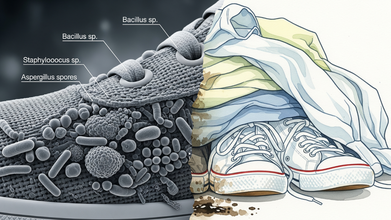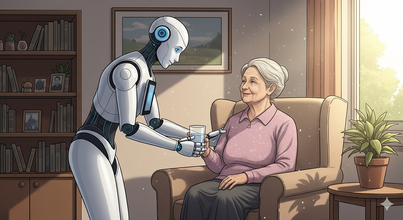- Health Conditions A-Z
- Health & Wellness
- Nutrition
- Fitness
- Health News
- Ayurveda
- Videos
- Medicine A-Z
- Parenting
- Web Stories
How Does Face Shaving Affect Your Skin?

Face Shaving And Skin Health (Credit - Canva)
There are new and trending health care tips, skin care tips, and many other life tips every day on social media. While many of these trends actually do help the viewers, others are not so useful. Some are even harmful for you! That's why it is suggested that whenever you make any changes to your lifestyle and diet, you should consult a professional. A recent trend that has even sparked the rise of products just based on highlighting the issue so that it can be resolved is face shaving.
Growing popular in the year 2023, this trend has now seen a new turn where people are buying face sprays that will show them the hair follicles on the face and give you the satisfaction of seeing these powdered follicles falling off it! But many people have started questioning whether it is worth it or not. While some believe it is good for a smoother base, others question whether you need to get rid of something you can’t even see without using a tool!
Is It Safe?
Innovative Dermatology explains face shaving offers a range of benefits for the skin. It acts as a gentle exfoliator, removing dead skin cells and revealing a brighter complexion. By removing fine, vellus hair, it can make the skin feel smoother and improve the appearance of makeup. Some women believe it can stimulate collagen production and reduce the appearance of fine lines and wrinkles. Additionally, it can enhance the absorption of skincare products and make makeup application more precise. Many women report increased confidence after incorporating face shaving into their routine.
What Are Potential Downsides Of It?
During an interview with Vogue India, a Dermatologist highlighted a few downsides to face shaving that can be avoided with the correct precautions like soaking your skin for a minute or two before you start shaving, it allows your skin to soften up, allowing you a smoother glide, then you apply a cleanser and then do a wet shave. Before adding face shaving into your routine, it's really important to consider your skin type and consult with a skincare professional. With proper technique and care, face shaving can be a valuable tool to achieve a smoother, more radiant complexion.
Irritation and Redness
Shaving can cause temporary irritation and redness, especially for those with sensitive skin. It's important to use a sharp razor and shaving cream to minimize irritation.
Ingrown Hairs
Improper shaving techniques can lead to ingrown hairs, which can be painful and unsightly. To avoid ingrown hairs, it's important to shave in the direction of hair growth and exfoliate regularly.
Regrowth
While shaving doesn't change the thickness or color of hair, the regrowth may feel coarser. However, this is temporary and will soften over time.
Maintenance
Regular shaving is required to maintain the benefits, which can be time-consuming. However, many women find it to be a worthwhile part of their skincare routine.
Skin Type Considerations
Individuals with certain skin conditions, like rosacea or severe acne, may not benefit from face shaving and should consult a dermatologist. It's important to listen to your skin and adjust your routine accordingly.
Rain Or Sweat, Your Shoes Might Be Dirtier Than Your Toilet; Essential Hygiene Tips To Follow

Credits: Health and me
You probably wash your shirts, pants, and jackets without thinking twice. But your shoes? Chances are they’ve been overlooked. Research shows they may be far dirtier than you realize harboring bacteria, fungi, and even fecal matter—and that skipping regular washes can affect not just hygiene but also skin health. Add in sweaty summers or damp, rainy months, and the case for washing clothes and shoes more regularly becomes even stronger.
A study from the Cleaning Industry Research Institute tested brand-new shoes worn for just two weeks. The results were startling: researchers found more than 421,000 bacterial units on the outside of the shoes and nearly 3,000 on the inside. Even more concerning, 96% of the pairs carried fecal bacteria, most likely picked up from public restrooms and sidewalks.
Another study across 30 homes showed that Clostridium difficile, a germ that can cause severe diarrhea and potentially life-threatening colon inflammation, was more likely to be found on shoe soles than on a toilet seat. Shoes also frequently carry E. coli, salmonella, MRSA, and fungi that can cause athlete’s foot or cellulitis. Because bacteria transfer easily—at rates as high as 90 to 99%—whatever is on your shoes is likely making its way onto your floors and eventually your hands, clothing, and skin.
Shoes aren’t the only culprits. Clothes that aren’t washed regularly become breeding grounds for bacteria, fungi, and mold, especially in warm or humid conditions. During monsoon season in tropical countries—or high-humidity summers elsewhere—clothes often stay damp for longer, which is perfect for fungal growth.
Dr. Geetika Srivastava, dermatologist explains that fabric choice and hygiene matter far more than most people think. “Artificial fabrics like polyester and nylon trap sweat and moisture, creating conditions for rashes, fungal infections, and acne. Natural fabrics like cotton and linen are more breathable and help the skin stay healthy,” she says.
The same logic applies globally, whether it’s monsoon rains in India, sticky New York summers, or wet winters in Northern Europe. Anywhere sweat and moisture meet skin, the risk of infection rises if clothes and shoes aren’t washed frequently.
What Happens When You Skip the Wash?
The consequences of neglecting shoes and clothes aren’t just about bad odor. They can include:
Skin infections: Fungal infections like athlete’s foot or ringworm thrive in damp shoes and sweaty clothes.
Respiratory risks: Shoes can carry bacteria such as Klebsiella pneumoniae, linked to lung infections.
Gastrointestinal illness: Pathogens like C. diff or E. coli can spread indoors from dirty shoes.
Foot complications: Poor hygiene increases risks of diabetic foot infections, nail fungus, or hookworm exposure in certain regions.
Even something as simple as letting damp clothes sit unwashed after being caught in the rain can trigger breakouts, rashes, or fungal growth.
How Often Should You Wash?
The frequency depends on how much exposure your clothes and shoes have:
Shoes: Athletic shoes worn daily should be washed every couple of weeks, while casual shoes may only need cleaning every few months. Machine washing removes 90–99% of bacteria, though wipes or sprays can help in between.
Clothes: Daily-wear clothing like undergarments, socks, and workout gear should be washed after each use. Jeans and jackets can go a few wears but should never be left damp after rain or sweat exposure.
Seasonal adjustments: During humid or rainy weather, increase wash frequency since dampness prolongs bacterial survival. In dry climates, spacing washes slightly longer may be safe, though odor is usually a good indicator.
Tips For Building Healthier Hygiene Habits
The Centers for Disease Control and Prevention (CDC) emphasizes foot and clothing hygiene as key to preventing infections. Basic steps include washing feet daily, drying them completely, changing socks regularly, and inspecting for cuts or fungal growth. Shoes should be left at the entrance to reduce bacterial transfer indoors, and hands should be washed after handling them.
For clothes, ensuring they’re thoroughly dried is as important as washing them. Wearing partially dried garments increases the risk of fungal infections, especially in humid climates. Dr. Srivastava advises avoiding tight clothes during damp or sweaty seasons, opting instead for loose fits in lighter shades that keep skin cooler and drier.
Washing clothes and shoes more regularly isn’t just a tropical or monsoon issue. In the United States, studies have shown that 90% of shoe bacteria can transfer directly to household floors, while in colder countries, damp winter boots often cause fungal infections if not cleaned and dried properly. In Australia, hot summers drive excessive sweating, making both footwear and clothing a hygiene challenge.
Regular washing may feel like a chore, but the payoff is huge, fewer illnesses, fresher skin, and longer-lasting clothes and shoes. Investing in breathable fabrics, proper drying, and routine cleaning is a simple but powerful step toward healthier living.
What this really means is that the laundry cycle shouldn’t end with shirts and pants. Shoes and the bacteria they drag along need equal attention. So the next time you think about skipping that wash, remember- it’s not just about smelling clean, it’s about staying healthy.
Dr. Geetika Srivastava, MBBS, MD (AIIMS) is a Dermatologist and Founder of Influennz Clinic in New Delhi, India
Deadly Flesh-Eating Bacteria Kills Two Oysters Kill Two: Is Climate Change Making Infection Worse?

(Credit-Canva)
In Louisiana, two more people have died after eating oysters contaminated with the flesh-eating bacteria, Vibrio vulnificus. This brings the total number of deaths from the bacteria to six so far this year. With 14 more people infected, the total number of cases in the state has reached 34, marking the highest rate of infection in a decade.
What Is Brain-Eating Bacteria/ Vibrio vulnificus?
Vibrio vulnificus is the most dangerous type of this bacteria. It causes about 200 illnesses each year, and as many as one in five of those infections are fatal—a much higher rate than other types of Vibrio. Vibrio bacteria live naturally in coastal waters, and people can get infected in two main ways:
Eating contaminated seafood
The most common way to get sick is by eating raw or undercooked shellfish, especially oysters. Oysters feed by filtering water, which can cause the Vibrio bacteria to build up inside them.
Wounds in water
The bacteria can enter the body through an open wound, such as a recent cut, scrape, piercing, or tattoo, when a person is in coastal water.
What Has Caused The Increase In Vibrio Bacteria?
Doctors and experts say that Vibrio vulnificus is becoming a yearly threat along the Gulf Coast and is now appearing further north along the Eastern Seaboard. Scientists believe that climate change is helping the bacteria spread as coastal waters get warmer. A recent study found that the northernmost cases are moving about 30 miles farther north each year.
A 2023 review published in the Microbiology Insights journal explained that as our oceans get warmer, a rare but dangerous "flesh-eating" bacterium called Vibrio vulnificus is becoming more common. This bacterium is now moving along the U.S. East Coast. It can cause serious infections that lead to limb amputations or even death within a day or two.
The bacteria can cause a severe infection called necrotizing fasciitis, which is when the flesh around an open wound starts to die. In July 2023, North Carolina reported three deaths from the infection after people with open wounds came into contact with coastal water. The state is now warning residents to be careful, especially during the warmer months.
Vibrio vulnificus thrives in warm, salty water. It can be found in sea animals and is often linked to eating raw or uncooked seafood, particularly oysters. The infection is also easily transmitted through small cuts or scrapes when a person is in seawater.
The symptoms of a Vibrio infection can be severe. In serious cases, a person may need multiple surgeries to remove dead or infected tissue, and sometimes even an amputation. These severe cases are most often seen in elderly people, those with weakened immune systems, or people with liver disease or diabetes.
Are People With Certain Diseases More At Risk?
The infection typically starts with a sudden fever and chills, followed by skin sores, usually on the legs or torso. In severe cases, it can lead to death very quickly. People with certain health conditions are at a much higher risk for serious infections, including those with:
- Diabetes
- Liver problems
- Kidney disease
- Weakened immune systems
- Those 65 and older
How Can You Protect Yourself?
According to the Center of Disease Control and Prevention, treating the infection requires antibiotics and sometimes aggressive surgery to remove dead tissue. In some cases, limb amputation is necessary. The best way to prevent the infection is to take a few simple steps:
- Do not eat raw or undercooked shellfish, like oysters.
- Avoid contact with warm seawater or brackish water if you have any open wounds.
- Wear protective clothing when handling raw shellfish.
- Cook shellfish thoroughly before eating it.
ChatGPT Robots To Take Over Elderly Care In South Korea. Could AI Change Age Care?

In South Korea, AI companion robots are being given to elderly people who live alone. These robots, called Hyodol, act as a comforting presence and a helpful tool for overworked eldercare staff. For seniors who lives alone in Seoul, the robot becomes like most treasured companion, a "lovely granddaughter" she talks to affectionately.
How Does AI Robots Transform Elderly Care
According to Taylor & Francis Online 2024 study, the Hyodol robot, a plush doll with built-in AI, is designed to keep seniors company in a nation where many older adults are deeply lonely. It Hyodol acts as a companion, offering services like religious chants, quizzes to help with memory, and daily reminders to take medicine. Media reports show that the Guro municipality in Seoul has given out over 400 of these robots, and more than 12,000 are in use across the country.
Eldercare workers say the robots have become their "eyes and ears," helping them monitor clients between visits. While the robots add to their workload with maintenance, workers feel it's worth it because of the comfort they bring. The bots provide a constant presence and someone to talk to, which can help ease feelings of loneliness and depression.
How Do Humans Bond With Bots?
Older adults often form strong connections with their Hyodols. They care for the dolls as if they were real grandchildren, feeding them pretend meals and dressing them in special outfits. Some people have even asked to be buried with their robots. Based on research at welfare centers and in seniors' homes, it shows that the robots create a "robotic multi-care network." This network includes the robots themselves, their monitoring system, elderly users, caregivers, company staff, and family members.
Instead of replacing human caregivers, the robots change how care work is done. They shift and share tasks, creating different kinds of care practices—some are hands-on, some are digital, some are close by, and some are done from a distance.
There are also ethical issues. Some seniors may become more isolated, staying home because they have a companion greeting them at the door. For those with dementia, the robots' words can be taken too literally. For example, after her Hyodol mentioned a stream, one elderly woman with dementia walked to a creek alone with her robot. The company has since removed phrases that could be misinterpreted.
Will AI Become New Age Care For Elderly?
Within this network, elderly users have found different ways to connect with the robot. Some see Hyodol as a "grandchild" and treat it with affection, while others view it as a way to stay in touch with their caregivers. The 2024 study shows that while the robots don't replace human caregivers, they do change and redistribute the work, proving to be a valuable addition to the eldercare system.
South Korea is facing a shortage of care workers, and the Hyodol program is a way to fill this gap. The robots are a much cheaper alternative to hiring more staff. While they can't replace human care, they act as a "central node" that connects people. The robots handle the first layer of oversight, alerting social workers when there's an issue.
The program has led to heartwarming moments, like a fashion show where seniors and their robots wore matching outfits. For many, the robot is not just a device, but a cherished friend. As one elderly woman said, after receiving her Hyodol, she no longer wanted to die.
© 2024 Bennett, Coleman & Company Limited

